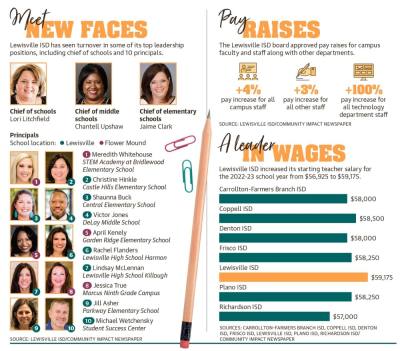Ahead of the 2022-23 school year, the district took steps to mitigate a shortage of substitutes and teachers as well as an increase in staff members retiring.
In LISD, about 420 positions are open for applicants as of July 21, according to its hiring site. These positions include support staff, teachers, campus leaders and temporary positions.
“Districts in our area and across the state are experiencing difficulties filling a variety of positions,” LISD Superintendent Lori Rapp said in an email. “For LISD in particular, we are noticing fewer qualified applicants, especially in our special education positions.”
The district has “aggressively marketed its openings,” by hosting job fairs and looked at ways to increase the applicant pool for the open positions, Rapp said.
This is not an LISD-specific problem, Rapp said. LISD saw an 11.8% teacher turnover rate based on 2020-21 data, according to the Texas Education Agency. The state averaged 14.3%.
“We will continue looking for ways to better compensate all our staff members,” Rapp said. “But more than that, what can make a significant difference is everyone joining our district in lifting our educators up and respecting their talents, skills and professionalism.”
Teacher turnover
To help mitigate some of that turnover, the LISD board of trustees approved a 4% pay increase to campus staff during an April 11 meeting. This includes a starting teacher salary of $59,175, which offers competitive wages in the region, according to LISD officials.
For example, Plano and Frisco ISDs offer first-time teachers $58,250 for the 2022-23 school year, according to the districts.
“[Teacher pay raises and a higher starting salary] were significant financial commitments and very clearly showed the board’s desire to keep our compensation highly competitive in the [Dallas-Fort Worth] metroplex,” Rapp said. “Certainly, compensation is a part of the puzzle for the statewide shortage of teachers. But I don’t think it would be accurate to say that is the only thing.”
Teacher and educator retention goes beyond compensation, according to The American Federation of Teachers—politics, the pandemic and burnout contribute, as well.
“The pandemic, combined with the political culture wars, has made the last two years the toughest in modern times for educators,” AFT President Randi Weingarten said in a July report.
The report came from the AFT Teacher and School Staff Shortage Task Force, which looked at addressing the nationwide shortage of teachers.
The task force was made up of 25 leaders from state and local affiliates across the country.
“It’s hard not to be stressed when the pandemic has created so much disruption and uncertainty—when you’re trying to give students individualized attention but your classes are too large or you are pulled away to cover extra classes or have students added to yours because of the shortages of staff,” Weingarten said.
Though officials said the pandemic contributed to the teacher shortage, the issue was seen well before 2020. All 50 states started the 2017-18 school year with teacher shortages. Every year, nearly 300,000 leave the profession, with two-thirds leaving before retirement age, according to the AFT.
Teacher turnover is nearly double that of other occupations, with 30% of teachers leaving within five years compared to 16% of engineers and 19% of nurses and lawyers, according to the AFT report.
“Educators have been on the frontline of a global pandemic, which will now impact a fourth school year,” Rapp said. “In addition to the demands placed on teachers throughout COVID[-19], they continue to experience increased demands resulting from legislation mandating changes to tutoring and required training in reading academies.”
Substitute shortages
While filling teaching positions is a priority for the district, staff shortages in local schools go beyond teachers and can also be seen among substitutes.
LISD saw a drop in substitute fill rates during a December board meeting. For example, the district filled 57% of requested substitute positions during the 2021-22 school year, as of December, which is the most recent data available. The rate has dropped nearly 30% from the 2018-19 school year when the fill rate was 87.8%, according to district data.
As a result, the board hired ESS, a third-party company, to hire and maintain the district’s substitutes in December.
ESS is an education company that assists districts with staffing and filling vacant roles, according to the district.
“The shortage of substitutes statewide has increased the amount of classes that teachers may have to cover in addition to their regular assignments, resulting in long work days and minimal breaks in their schedule,” Rapp said. “Teachers who were hailed as heroes when the pandemic started are now increasingly finding themselves being mistreated or targets of frustration.”
Addressing shortages
The district saw a number of administrators also leaving their positions. For example, the district’s former Superintendent Kevin Rogers announced his retirement in November. Rogers served as superintendent since 2015.
Among other top leaders who are new this school year are the district’s chief financial officer, chief of schools, chief of middle schools, executive director of finance and chief of elementary schools.
About 10 out of the district’s 70 campuses will also see new principals at the start of the new school year.
To help build a stronger pool of candidates, LISD awarded 11 paraprofessionals $124,500 worth of grants to help fund their education and complete their teaching certifications in May.
“This grant helps so much. It’s going to help me focus on my school and my daughter because I’ve been working two jobs,” recipient Sarahi Reyes said in a district news release. “This is going to alleviate a lot of stress that I’ve had and motivate me to finish school and become a teacher at LISD.”







